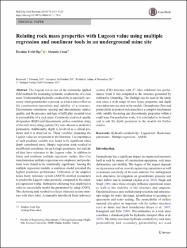| dc.contributor.author | Öğe, İbrahim Ferid | |
| dc.contributor.author | Çırak, Mustafa | |
| dc.date.accessioned | 2020-11-20T14:42:32Z | |
| dc.date.available | 2020-11-20T14:42:32Z | |
| dc.date.issued | 2019 | |
| dc.identifier.issn | 1435-9529 | |
| dc.identifier.issn | 1435-9537 | |
| dc.identifier.uri | https://doi.org/10.1007/s10064-017-1179-0 | |
| dc.identifier.uri | https://hdl.handle.net/20.500.12809/1082 | |
| dc.description | 0000-0001-6243-8268 | en_US |
| dc.description | WOS: 000460046500031 | en_US |
| dc.description.abstract | The Lugeon test is one of the commonly applied field methods for measuring hydraulic conductivity of a rock mass. Understanding hydraulic conductivity is especially necessary when groundwater is present, as it has a direct effect on the construction operations and stability of a structure. Discontinuity orientation, spacing and discontinuous surface quality, and the presence and type of infill play essential roles in permeability of a rock mass. Commonly used rock quality designation (RQD) and discontinuity surface condition rating of the rock mass rating system (Dc) were chosen as predictive parameters. Additionally, depth is involved as a critical predictor and it is observed so. Three variables impacting the Lugeon value are not present in the literature. The importance of each predictor variable was found to be significant while depth contributed more. Simple regression work resulted in insufficient correlation for each single parameter, but indicated they have relevance to the Lugeon value. In addition to linear and nonlinear multiple regression studies, Box-Cox transformation multiple regression was employed and predictions were found to be statistically significant. Among the multiple regression models, a nonlinear model provided the highest prediction performance. Utilization of the adaptive neuro-fuzzy inference system (ANFIS) enabled researchers to predict the Lugeon value precisely, compared to the multiple regression works. Subtractive clustering was employed in order to successfully model the parameters by using ANFIS. The clustering task resulted in a fuzzy inference system structure with three rules. A manually introduced fuzzy inference system (FIS) structure with 27 rules exhibited low performance when it was compared to the structure generated by subtractive clustering. The findings can be used in the study area since a wide range of rock types, properties and depth were taken into account in the models. Groundwater flow and permeability in jointed rock mass have a complex mechanism with variable fracturing and discontinuity properties within a small area. For prediction work, it is concluded to be beneficial to add the depth parameter to the models for further studies. | en_US |
| dc.item-language.iso | eng | en_US |
| dc.publisher | Springer Heidelberg | en_US |
| dc.item-rights | info:eu-repo/semantics/openAccess | en_US |
| dc.subject | Hydraulic Conductivity | en_US |
| dc.subject | Lugeon Test | en_US |
| dc.subject | Rock Mass Parameters | en_US |
| dc.subject | Multiple Regression | en_US |
| dc.subject | ANFIS | en_US |
| dc.title | Relating rock mass properties with Lugeon value using multiple regression and nonlinear tools in an underground mine site | en_US |
| dc.item-type | article | en_US |
| dc.contributor.department | MÜ, Mühendislik Fakültesi, Maden Mühendisliği Bölümü | en_US |
| dc.contributor.institutionauthor | Öğe, İbrahim Ferid | |
| dc.contributor.institutionauthor | Çırak, Mustafa | |
| dc.identifier.doi | 10.1007/s10064-017-1179-0 | |
| dc.identifier.volume | 78 | en_US |
| dc.identifier.issue | 2 | en_US |
| dc.identifier.startpage | 1113 | en_US |
| dc.identifier.endpage | 1126 | en_US |
| dc.relation.journal | Bulletin of Engineering Geology and the Environment | en_US |
| dc.relation.publicationcategory | Makale - Uluslararası Hakemli Dergi - Kurum Öğretim Elemanı | en_US |


















